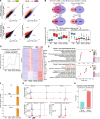Antiviral memory B cells exhibit enhanced innate immune response facilitated by epigenetic memory
- PMID: 38552009
- PMCID: PMC10980274
- DOI: 10.1126/sciadv.adk0858
Antiviral memory B cells exhibit enhanced innate immune response facilitated by epigenetic memory
Abstract
The long-lasting humoral immunity induced by viral infections or vaccinations depends on memory B cells with greatly increased affinity to viral antigens, which are evolved from germinal center (GC) responses. However, it is unclear whether antiviral memory B cells represent a distinct subset among the highly heterogeneous memory B cell population. Here, we examined memory B cells induced by a virus-mimicking antigen at both transcriptome and epigenetic levels and found unexpectedly that antiviral memory B cells exhibit an enhanced innate immune response, which appeared to be facilitated by the epigenetic memory that is established through the memory B cell development. In addition, T-bet is associated with the altered chromatin architecture and is required for the formation of the antiviral memory B cells. Thus, antiviral memory B cells are distinct from other GC-derived memory B cells in both physiological functions and epigenetic landmarks.
Figures






Similar articles
-
B Cell Activation and Response Regulation During Viral Infections.Viral Immunol. 2020 May;33(4):294-306. doi: 10.1089/vim.2019.0207. Epub 2020 Apr 23. Viral Immunol. 2020. PMID: 32326852 Free PMC article. Review.
-
Viral Replicative Capacity, Antigen Availability via Hematogenous Spread, and High TFH:TFR Ratios Drive Induction of Potent Neutralizing Antibody Responses.J Virol. 2019 Mar 5;93(6):e01795-18. doi: 10.1128/JVI.01795-18. Print 2019 Mar 15. J Virol. 2019. PMID: 30626686 Free PMC article.
-
Long-lasting T cell-independent IgG responses require MyD88-mediated pathways and are maintained by high levels of virus persistence.mBio. 2013 Nov 5;4(6):e00812-13. doi: 10.1128/mBio.00812-13. mBio. 2013. PMID: 24194540 Free PMC article.
-
Early T Follicular Helper Cell Responses and Germinal Center Reactions Are Associated with Viremia Control in Immunized Rhesus Macaques.J Virol. 2019 Feb 5;93(4):e01687-18. doi: 10.1128/JVI.01687-18. Print 2019 Feb 15. J Virol. 2019. PMID: 30463978 Free PMC article.
-
Unravelling humoral immunity in SARS-CoV-2: Insights from infection and vaccination.Hum Antibodies. 2024;32(3):85-106. doi: 10.3233/HAB-230017. Hum Antibodies. 2024. PMID: 38758995 Review.
Cited by
-
Antiviral nanomedicine: Advantages, mechanisms and advanced therapies.Bioact Mater. 2025 Jun 5;52:92-122. doi: 10.1016/j.bioactmat.2025.05.030. eCollection 2025 Oct. Bioact Mater. 2025. PMID: 40530413 Free PMC article. Review.
-
Metabolism and epigenetics in cancer: toward personalized treatment.Front Endocrinol (Lausanne). 2025 Jul 25;16:1530578. doi: 10.3389/fendo.2025.1530578. eCollection 2025. Front Endocrinol (Lausanne). 2025. PMID: 40786181 Free PMC article. Review.
-
Constraints and tunability of antigen-agnostic memory durability.bioRxiv [Preprint]. 2025 Jul 19:2025.07.18.663399. doi: 10.1101/2025.07.18.663399. bioRxiv. 2025. PMID: 40791445 Free PMC article. Preprint.
-
Harnessing Epigenetics: Innovative Approaches in Diagnosing and Combating Viral Acute Respiratory Infections.Pathogens. 2025 Feb 1;14(2):129. doi: 10.3390/pathogens14020129. Pathogens. 2025. PMID: 40005506 Free PMC article. Review.
References
-
- Tarlinton D., Good-Jacobson K., Diversity among memory B cells: Origin, consequences, and utility. Science 341, 1205–1211 (2013). - PubMed
-
- Tangye S. G., Tarlinton D. M., Memory B cells: Effectors of long-lived immune responses. Eur. J. Immunol. 39, 2065–2075 (2009). - PubMed
-
- Weill J. C., Le Gallou S., Hao Y., Reynaud C. A., Multiple players in mouse B cell memory. Curr. Opin. Immunol. 25, 334–338 (2013). - PubMed
-
- Kurosaki T., Kometani K., Ise W., Memory B cells. Nat. Rev. Immunol. 15, 149–159 (2015). - PubMed
Publication types
MeSH terms
Substances
LinkOut - more resources
Full Text Sources
Molecular Biology Databases
Miscellaneous

